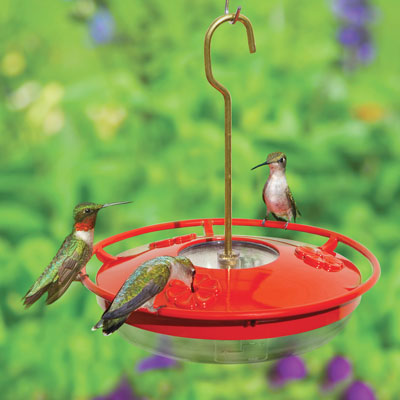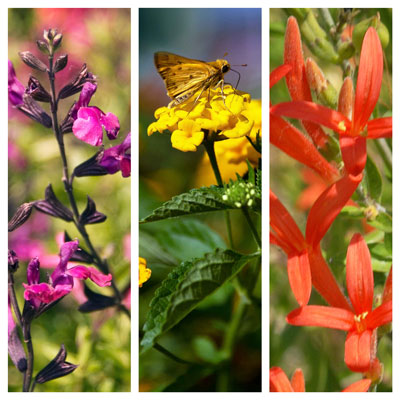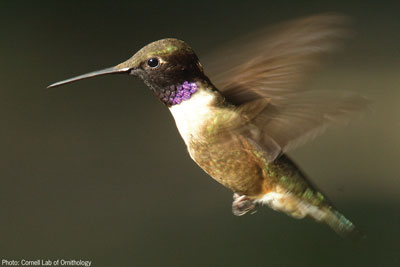Let’s Hear it for Hummers!
Ever since Lynn and I visited my cousin Jeanne and her husband James near Grapeland and sat there in their sunroom watching probably 20 hummingbirds drain a feeder dry in a few hours, I’ve wanted to get one hung outside our back window.

We bought this same High Perch Feeder from Wild Birds Unlimited last week and we got it hung yesterday – and had a visitor first thing this morning! Hopefully ours will soon be attracting many more Ruby-throated hummers like this one. (Photo courtesy Wild Birds Unlimited.)
Our 9-year-old grandson lives near us, and he, Lynn and I paid a visit to David Hurt of Wild Birds Unlimited on Lovers Lane just west of the Tollway in Dallas a few days ago. David has been selling birding supplies for a long time, and he was really helpful to explain the secrets to success. I had heard most of them, but it was good to hear them again – in the expert’s own voice.
David tells me that July, August and September are the best months for most people to attract multiple hummingbirds to their yards, whether they live in the countryside or the city. That’s due to the increased population from the breeding season along with the need for the hummers to prepare for their long migrations south.
Quick points on feeder placement…
• Hang feeder near windows for best visibility.
• Hang feeder out of sunlight so it won’t overheat.
• Hang high enough that predators won’t be able to reach the hummers as they’re feeding.
• Keep feeders out of sight of one another so bully birds won’t fly back and forth creating havoc.
• Perches and twigs nearby give hummers a place to rest or watch before feeding.

Female Ruby-throated hummingbird with babies in nest. Females do all the incubating, feeding. (Photo courtesy Wild Birds Unlimited.)
Mixing nectar…
• It’s really quite simple: one part of sugar to four parts of very hot water. Stir and let cool.
• Add no dye or food coloring of any type. Natural plant nectar is clear. Birds are attracted to the flower colors, and your feeder will take care of that for you.
• You can add a preservative to slow the spoiling process. Your birding supplier will have it available.
• Replace nectar every couple of days especially in the hot weather. Mixed nectar can be stored in the refrigerator for a week or more until you’re ready to use it.
• Wash all parts of your feeder carefully before you refill it. Some of the better types are dishwasher-safe.
Plants that will also attract hummingbirds…
Hummingbirds specialize in long, tubular flowers, and Texas has been blessed with many fine candidates. You’ll find hummers hanging out around penstemons, phlox, all kinds of salvias, lantanas, spiderflowers, Texas sage (ceniza), zinnias, honeysuckles, crossvine, cypressvine, trumpetcreeper (Madame Galen is better in landscapes than the native type), angelonia, pentas, flame acanthus, hibiscus, shrimp plant, turk’s cap and many others.

Tubular flowers attract hummingbirds. From left: Salvia greggii (autumn sage), trailing lantana and flame acanthus. (photos by Neil Sperry)
Planting these near your feeders, either in beds or in pots, will magnify your successes.
Did you know…
• …that you don’t have to worry about leaving your feeders up too long in the fall?
Hummingbirds’ natural internal clocks tell them when it’s time to migrate. They’re not going to hang around your feeders too late into the season just because you’ve left out sweet treats for them.

Black-chinned hummingbird in flight. (Photo courtesy Wild Birds Unlimited, from Cornell Lab of Ornithology.)
• …that there are 328 recognized species of hummingbirds, and that all of them are in the Western Hemisphere? But most of them are around the Equator?
We have only 20 or so species in the U.S. and Canada, and they all migrate south into tropical areas (or along the California coast) for the winter. In Texas we have primarily the Ruby-throated hummingbird (eastern half of the state) and the Black-chinned hummingbird (western half of the state).
Want a handy little book?
I picked up a copy of Enjoying Hummingbirds More by Nancy Newfield (a publication of Bird Watcher’s Digest) at Wild Birds Unlimited. They have seven stores in the Metroplex and upwards of 20 across Texas.
